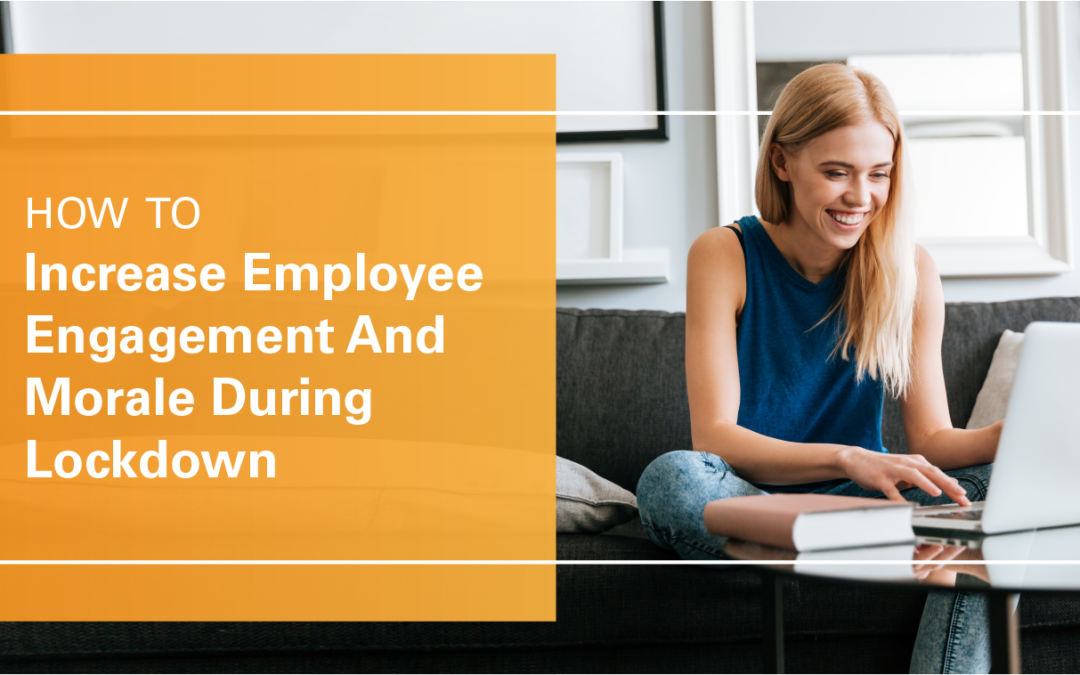HOW TO INCREASE EMPLOYEE ENGAGEMENT AND MORALE DURING LOCKDOWN
The benefits of high levels of employee engagement are significant to any organisation. An increase in employee engagement can help to improve work culture, reduce staff turnover, increase productivity, build better work and customer relationships and can also impact company profitability.
Research from the Qualtrics 2020 employee experience trends survey shows that highly engaged employees are 10% more likely to exceed performance expectations, while companies with high levels of engagement achieve 2.5 x more revenue growth.
Employee engagement can often decrease when there are any major shifts in a company’s culture. Unfortunately, the COVID pandemic has forced many businesses to shift to a working from home or hybrid model, and this can have an impact on staff engagement and morale.
Working from home arrangements have forced much of the population to combine their work and home spaces, which has had an impact on their productivity at work, especially for those with young families. According to the Families in Australia Survey: Towards COVID Normal, 49% of parents surveyed who were working from home reported finding it difficult to combine work and care responsibilities.

Extended lockdown periods and increasing uncertainty as a result of the pandemic have also led to an increase in psychological distress among the population.
According to the Household impacts of COVID-19 Survey in June 2021, one in five (20%) Australians experienced high or very high levels of psychological distress in the last four weeks.
This is similar to March 2021 (20%) and November 2020 (21%), periods when much of Australia were facing lockdowns.
It’s evident that now more than ever, people that are in management need to have a stronger focus on the wellbeing of their employees.
So, we’ve compiled a list of five management strategies that can help to boost morale within an organisation, and ultimately increase employee engagement.
1.Take a supportive management approach
In a working from home environment, it’s especially important for managers to have a supportive relationship with their employees. Having daily internal meetings and frequent one-on-one check-ins with employees makes them feel included in what’s happening within the organisation. This coaching-style approach also allows management to easily assess and measure progress whilst also boosting team productivity.
In addition to this, leaders should invest in the learning and development of their employees by giving them individual growth opportunities within the business. This can be through education and training via virtual learning platforms, as well as through constructive feedback. If the employee feels that they are growing within the business, it will likely increase their engagement as they feel a sense of purpose and achievement in progressing toward their career goals.

Ekaterina Bolovtsova for Pexels
2. Promote employee resilience
Resilience is a powerful tool that can help employees adapt and cope with the challenges that stem from the ups and downs of the pandemic. Resilient people have strong resources to react to stress and conflict in a positive way and learn from these experiences. They’re also flexible, adaptable and optimistic, and are able to ask for help when they need it. A resilient employee is more likely to adapt well to the changed working conditions as a result of the pandemic, and thus, stay more engaged with their work.
A workplace culture that promotes resilience is key. Create a space where employees feel safe to speak up if they need help. Be open with employees about the happenings within the company – both the good and the bad. It’s also important to lead by example and maintain composure during times of heightened stress. Another way of promoting resilience is to have debriefing sessions after an employee faces a challenge or stressful event, encouraging them to reflect on both the positive and negative outcomes of the experience.
Resilience workshops, checklists, guides and other educational resources are great foundations for promoting employee resilience. It’s also important to ensure that employees are aware of and have access to your EAP services in case they need additional support for their mental health. Another way to boost employee resilience is to invest in a bespoke wellbeing platform built by Springday for your company.
3. Build positive relationships with employees
Another great way to boost employee engagement in the workplace is to focus on fostering authentic, caring relationships with your colleagues. Workplace relationships can affect an employee’s stress levels, productivity and general feelings of happiness. In fact, 9 in 10 Australian employees believe mentally healthy workplaces are important. Strong social connections can be the key ingredient to improving emotional wellbeing and workplace productivity.
Implement initiatives and strategies for employees to stay connected when working remotely. Weekly virtual catchups with colleagues and peers are a great way to get to know each other on a personal level. You can organise fun activities to do as a team, whether that’s a virtual game or a live cook-along, or a virtual sharing space where colleagues can post photos from their life in lockdown.
Having fun together not only breaks up the routine but also encourages creativity and collaboration. Building positive relationships with your employees boosts their productivity because they want to put in more of an effort, knowing that management cares for them as an individual.
However, It’s important to make sure that these spaces aren’t creating an additional burden for employees. Some individuals may experience ‘Zoom fatigue’ as a result of prolonged video chats, whereby they find video calls particularly exhausting and psychologically fatiguing. Virtual catchups should create space to nurture and build workplace relationships, while remaining an optional choice.

4. Give employees flexibility
A change of environment has been one of the biggest challenges that the pandemic has presented; going from the office – where everyone is among colleagues in work-mode, to a makeshift workspace at home can be disruptive to workflow.
Be conscious of the challenges employees are facing, whether that be the struggles of living at home, having limited space to work, taking care of young children, or juggling background noise such as a neighbour doing loud renovations. These changes in the work environment mean that the typical hours of productivity are altered.
Creating a positive work environment for your employees, even in a working from home setting, is vital for increasing their engagement. One of the best ways to do this is to give flexibility to your employees. This allows them to adjust their work schedules to best suit their needs.
When given flexible hours instead of the classic 9-5 workday, people tend to be more productive, less stressed, and more engaged. This is especially beneficial for employees who are juggling homeschooling and working from home during lockdown.
5. Regularly give feedback and show gratitude
In a more on-demand world, the need for consistent and regular reviews is more vital, rather than relying on the standard annual review. Working remotely can make it especially difficult for employees to seek and receive feedback because they can’t just walk up to their manager’s desk and discuss their work. This is why it’s important to schedule frequent one-on-one meetings with employees. This not provides the opportunity to create a constant feedback loop.
In addition to regular feedback, it’s also important for those in management to regularly express gratitude to employees. Everyone wants to feel appreciated, and a simple ‘thank you’ can go a long way in motivating employees to work harder and be more productive. Celebrate successes within the team, even if it’s in a virtual setting, and make sure to give recognition to those who are instrumental to the organisation’s achievements.
In Summary
At the end of the day, employees are human beings, and how well they perform is often tied to how well they’re engaged at work. Focusing on building employees up through regular feedback and encouraging development, as well as improving workplace relationships and showing gratitude, can help to improve employee performance. On a very basic level, this is simply because if employees are engaged and happy within their role, they are more likely to be performing at their best.










